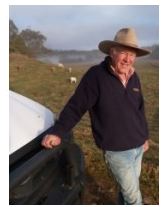



Questioning Grassland Beef Production Costs
An Australian farmer has realised that proper cost of production analysis can improve the bottom line.Rob Perkins produces grass-fed cattle for Ebor beef of New South Wales and admits that he wasted time in trying to save on a barrel of drench rather than scrutinising his costs.
“After three years my CoP has averaged out at about $1.10/kg. I know my biggest costs are pasture and fertiliser and I scrutinise these large costs to make sure I am getting value for money,” he said.
“Having intimate knowledge of my costs allows me to narrow my focus and takes it off trying to save $10 on drench.”
After four years with the Ebor Beef Profit Group, Rob continues to value the insight that calculating his CoP gives him into his heavy feeder steer operation. The big costs in Rob’s operation stem from the high input, highly improved, intensively managed pasture base.
Through analysing the books, Mr Perkins found that fertiliser was his biggest cost and could then control it accordingly.
To manage his fertiliser input costs and maintain high quality pastures, Rob has a simple philosophy of replacing the nutrients removed by the cattle.
“Because we are monitoring the stock weights monthly, and know how many kilograms of beef we produce, we can replace the nutrients per kilogram of beef removed. We also soil test and occasionally tissue test,” Rob said.
Rob is acutely aware that monitoring and tactical control of stock, coupled with high pasture utilisation, are vital to maximise kilograms of beef per hectare.
“The trader steer market probably has the highest cents per kilogram. We have the scales linked to the NLIS devices so we can monitor stock weights monthly and draft off the tops. We are aiming to get the cattle to 470–480kg,” Rob said.
“I also know the price I am going to get for my animals before they leave the farm.”
Profit From Pastures
Another challenge in Rob’s enterprise is utilising the summer feed flush and he always runs slaughter cattle, as well as the feeder steers, to assist in achieving this.
Rob likes to increase the numbers of crossbred cattle in summer to consume thesurplus feed and uses MSA to maximise the returns from these cattle.
As he is running a trading, as opposed to a breeding, operation, gathering the data to calculate Rob’s CoP takes time but he insists it’s no deterrent.
“If the group dissolved tomorrow I would continue to calculate my CoP for my own benefit,” he said.
“If you have a good accounting package, the process of collecting the data is not onerous. We pull most of our figures off the information prepared for the accountant, and then it is simply a matter of adding up the kilograms of beef that have entered and exited the property.”
The Ebor Beef Profit Group benefits from the sharing of information about each individual enterprise.
“The first year we kept our CoP private but it didn’t take long before we just opened the books,” Rob said.
“It has been a great policy as nothing is divulged outside the four walls of the meeting. Different producers have different costs of production and when you understand their philosophy, and the goals they have for their business, things start to fall into place.”




